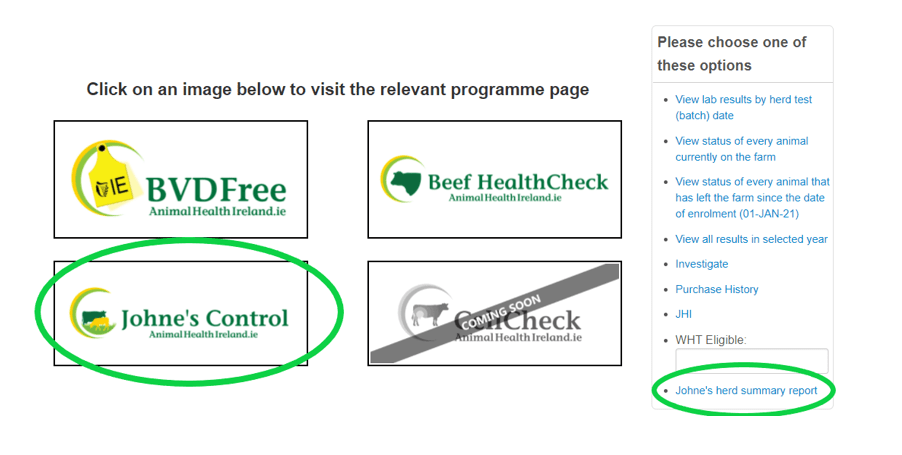Herdowners who are registered in the Irish Johne’s Control Programme can now get a Summary Report of all current and recent testing and risk assessments on ICBF.
This new report presents all data relevant to Johne’s control for each herd in a single, easily understood, downloadable two-page document. The purpose of the report is to inform discussions about Johne’s disease control between herdowners and their approved veterinary practitioners.
The initial information identifies the herd and how long it has been participating in the Johne’s control programme. There is a placeholder for the Johne’s Herd Indicator which will be a measure of a herd’s relative level of risk of infection, which is currently under development.
The report then provides a snapshot of all animals’ test results conducted under the programme per year (Section 4), including ELISA tests on blood or milk samples and ancillary tests (PCR or culture) on dung samples. It also shows gaps in undertaking specified follow-up testing (ELISA re-testing or PCR) each year, and whether there are animals needing follow-up testing by PCR or ELISA that are still in the herd.
The report next shows the number and percentage of test-positive animals (with positive and inconclusive ELISA test results) each year, for the whole herd and broken down by age cohorts (Section 5). This enables changes in the proportion of test positives to be followed over time, and any high-risk cohorts (high proportion of test-positive animals) to be identified for special monitoring and management.
It also tables the movements of animals into the herd per year (Section 6). Animal introductions are the most likely way by which a herd will become infected, so this data enables owners to review and mitigate this risk. Much of the above data is already presented in the annual veterinary risk assessment and management plan (VRAMP) in the programme, although the Summary Report conveniently brings it all together and can be downloaded from ICBF at any time. Additional new information, not currently provided in the VRAMP, is also provided through graphical displays comparing VRAMP scores (by section and total) against other programme herds (benchmarking), and of VRAMP scores and benchmarks over time (Section 7). These graphics will help to interpret the scores and indicate areas of herd management (calves and pre-weaned heifers, grazing heifers, cow hygiene, and calving management) where there is the greatest opportunity and need for improvement.
Much of the above data is already presented in the annual veterinary risk assessment and management plan (VRAMP) in the programme, although the Summary Report conveniently brings it all together and can be downloaded from ICBF at any time. Additional new information, not currently provided in the VRAMP, is also provided through graphical displays comparing VRAMP scores (by section and total) against other programme herds (benchmarking), and of VRAMP scores and benchmarks over time (Section 7). These graphics will help to interpret the scores and indicate areas of herd management (calves and pre-weaned heifers, grazing heifers, cow hygiene, and calving management) where there is the greatest opportunity and need for improvement.
How to access the new Herd Johne’s Summary Report?
To gain access to the AHI dashboards, simply log in to your ICBF account. If you have forgotten your password, text the word PASS to 089 4577663 or alternatively, you can contact the HerdPlus office on 023-8820452 or email [email protected]. Once you have logged in to the ICBF website, you will see a menu bar running along the top of the screen. To access the various dashboards, select SERVICES then select AHI ANIMAL HEALTH from the dropdown menu. Here you will see the various AHI programmes that are available. Simply select Johne’s Control. Once on the Johne’s Control landing screen, simply select “Johne’s herd summary report”. The objective in providing the new Herd Johne’s Summary Report is to make control of Johne’s disease easier to understand and implement. All dairy herds in Ireland will benefit economically from preventing or controlling Johne’s disease, and even more so by using this and other funded supports in the Irish Johne’s Control Programme.
The objective in providing the new Herd Johne’s Summary Report is to make control of Johne’s disease easier to understand and implement. All dairy herds in Ireland will benefit economically from preventing or controlling Johne’s disease, and even more so by using this and other funded supports in the Irish Johne’s Control Programme.
How to join the programme?
It is easy to join the programme; start today by registering with Animal Health Ireland either on-line https://animalhealthireland.ie/programmes/johnes-disease/ or by calling 071 967 1928.

